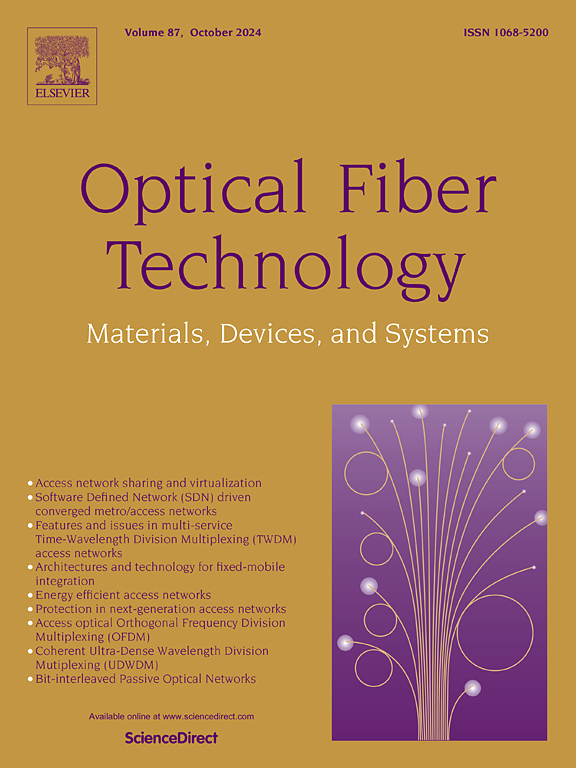125 μm包层七芯棒辅助多芯光纤中改进的非对称棒排列和旋转,增强了C和L波段的短距离通信
IF 2.7
3区 计算机科学
Q2 ENGINEERING, ELECTRICAL & ELECTRONIC
引用次数: 0
摘要
为了实现C波段和l波段的低串扰和高效传输,提出了一种包层直径为125 μm的新型七芯六角形棒辅助多芯光纤(RA-MCF)。通过在中心核心(C0)周围策略性地使用不对称的抽油杆布置,以及抽油杆位置从0°到120°的系统变化,该设计有效地破坏了均匀模式耦合路径,与传统的对称配置相比,显著降低了XT。分析建模和有限元方法(FEM)仿真验证了设计的有效性,表明c波段的平均XT水平约为-45 dB/km,整个l波段的XT水平都是可接受的。利用40 μm的核心间距,所提出的RA-MCF实现了强大的功率传输,同时在两个频段保持最小的XT。优化后的光纤设计符合ITU-T G.655和G.656标准,在1550 nm处具有低弯曲损耗(0.0157 dB)和可接受的色散(14.4 ps/(nm⋅km))。这些特点使所提出的光纤成为高密度城域网和数据中心互连的理想选择,确保可靠的短距离传输和增强的信号隔离。本文章由计算机程序翻译,如有差异,请以英文原文为准。
Innovative asymmetrical rod arrangement and rotation in 125-μm-cladding seven-core rod-assisted multicore fiber for enhanced short-reach communication in C, and L Bands
A novel seven-core hexagonal rod-assisted multi-core fiber (RA-MCF) with a 125-m cladding diameter is proposed to achieve low crosstalk (XT) and efficient transmission across the C- and L-bands. Through the strategic use of an asymmetrical rod arrangement around the central core (C0) and systematic variation of rod positions from 0°to 120°, the design effectively disrupts uniform mode coupling pathways, significantly reducing XT compared to conventional symmetrical configurations. Analytical modeling and finite element method (FEM) simulations validate the design’s efficacy, demonstrating average XT levels of approximately -45 dB/km in the C-band and acceptable XT levels throughout the L-band. Utilizing a core pitch of 40 m, the proposed RA-MCF achieves robust power transfer while maintaining minimal XT across both bands. The optimized fiber design adheres to ITU-T G.655 and G.656 standards, exhibiting low bending loss (0.0157 dB) and acceptable dispersion (14.4 ps/(nmkm)) at 1550 nm. These features render the proposed fiber an ideal candidate for high-density metro networks and data center interconnects, ensuring reliable short-reach transmission with enhanced signal isolation.
求助全文
通过发布文献求助,成功后即可免费获取论文全文。
去求助
来源期刊

Optical Fiber Technology
工程技术-电信学
CiteScore
4.80
自引率
11.10%
发文量
327
审稿时长
63 days
期刊介绍:
Innovations in optical fiber technology are revolutionizing world communications. Newly developed fiber amplifiers allow for direct transmission of high-speed signals over transcontinental distances without the need for electronic regeneration. Optical fibers find new applications in data processing. The impact of fiber materials, devices, and systems on communications in the coming decades will create an abundance of primary literature and the need for up-to-date reviews.
Optical Fiber Technology: Materials, Devices, and Systems is a new cutting-edge journal designed to fill a need in this rapidly evolving field for speedy publication of regular length papers. Both theoretical and experimental papers on fiber materials, devices, and system performance evaluation and measurements are eligible, with emphasis on practical applications.
 求助内容:
求助内容: 应助结果提醒方式:
应助结果提醒方式:


